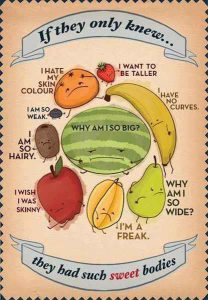When I was younger, I had regular contact with at least two people who I later found out were anorexic. I had no idea. Many of us think that, because of high-profile cases such as the late Princess Diana, we are all highly aware of eating disorders, who gets them, and how to spot them. In fact, this could not be further from the truth.
Did you know that in Britain around 8% of adults over the age of 16 have been diagnosed with an eating disorder? I didn’t. It’s a frightening figure, and it’s getting worse. A rise of around 7% a year in hospital admissions for eating disorders has been reported. Eating Disorders Awareness Week aims to raise awareness of the issues surrounding eating disorders and ensure that people in this situation have access to appropriate, effective help. So, this week I’m talking about what eating disorders are, how to tell if somebody has one, and what you can do about it. But firstly I’d like to bust some commonly-held myths.
What are Eating Disorders?
An eating disorder is a serious mental illness. It’s played out in ongoing, highly disordered behaviours around food, but the underlying cause may not be related to food at all. Instead, it’s connected to the way the person feels. Extreme food behaviours may help the person to feel better, or more in control.
Eating Disorders: Myths and Realities
Many eating disorders may go unrecognised because there are many stereotypes around who has an eating disorder. Here are just a few.
Myth: Eating disorders are a teenage problem.
Reality: Although eating disorders do primarily affect young people, you can develop an eating disorder at any age. Some people have been known to develop eating disorders in their 70s, and in 2015 15% of calls to the BEAT eating disorders helpline were from people aged 40 or over.
Myth: Only girls have eating disorders.
Reality: It’s estimated that 15-25% of people with eating disorders are male.

Being very slim is not necessarily an indication of an eating disorder; people come in all shapes and sizes!
Myth: You can tell who has an eating disorder because they are very skinny or very fat.
Reality: People come in all shapes and sizes, and being over or underweight does not mean you have an eating disorder. In fact, around 80-85% of people with eating disorders are not underweight. People with bulimia, for example, are very often within the ‘normal’ weight range.
Myth: Eating disorders are a ‘white person’s illness’.
Reality: Around 39% of us believe that white people are more likely to suffer from eating disorders than other ethnicities. The truth is that eating disorders are ‘colour blind’, and affect all ethnicities equally. However, the stereotype can prevent people from seeking help because they think eating disorders aren’t ‘supposed’ to happen to them. In a recent survey only around 52% of minority ethnic people felt comfortable asking help from a health professional in relation to an eating disorder compared with 64% of white people. Of course, this may reflect cultural or social differences relating to how different groups relate to health professionals in general, but it’s also likely to mean that eating disorders in the minority ethnic community go unrecognised.
Myth: Eating disorders can be corrected with dietary advice.
Reality: An eating disorder is a mental illness. Whilst dietary advice may help change misconceptions around food or give people tools to distinguish what they think they are eating from what they are really eating, or support them on the road to recovery, dietary therapy does not deal with the underlying issue. For this reason myself and other nutritional therapists are not qualified to work with anyone with a diagnosed eating disorder; they must be referred to a medical professional.
Myth: You can’t get better from an eating disorder
Reality: Current research shows that around 45% recover fully from anorexia or bulimia with many others showing significant improvement. Obviously this figure is still much lower than it should be, but it does offer hope that eating disorders need not necessarily be for life.
Would you like this information and more on video? Join my FREE Facebook group, and get this and much more, including recipes, tips and chat.
Would you like more information on eating disorders? Visit the BEAT website.
Next time: What are eating disorders and how do you recognise them?



